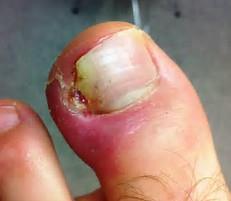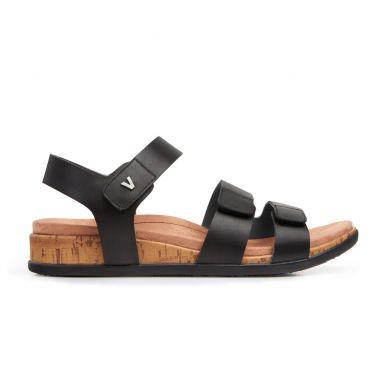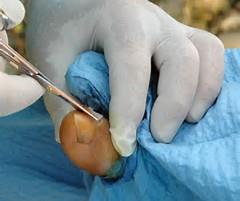Many people suffer from ingrown toenails and try various at-home treatments for ingrown toenails before visiting a podiatrist. At home, ingrown toenail treatment can be quite effective in managing ingrown toenails if a regular care and prevention routine is followed and the severity of the ingrown toenail symptoms are mild. However, persistent ingrown toenails can result in significant foot pain and sore feet requiring treatment from a podiatrist.
Ingrown toenail cutting at home
One of the simplest methods of managing ingrown toenails is regular trimming or cutting of the nail to prevent it from growing inwards. However, the technique is quite important. Your podiatrist will be able to teach you the best way to trim your toenails to keep them in check. It is important to follow the natural curvature of the nail when trimming ingrown toenails. Cutting down the sides can result in sharp edges that pierce the skin and cause further problems or infections. It is also important not to trim the nails too short, particularly if your feet are swollen or puffy. The objective is to keep the corners of the nail at a natural level rather than digging into the skin. While ingrown toenail treatment can be done at home, it is best done either by a podiatrist or under the supervision of a podiatrist.
Regular pedicures are another foot pain treatment used by sufferers of ingrown toenails. This can be an effective strategy in minor cases, however, there is always the risk of infection. Additionally, some nail technicians use nail trimming techniques that are not effective as ingrown toenail treatments.
Over the Counter Treatments for Ingrown Toenail Infections
If your toe is looking red or irritated around the nail area, it is possible you have a nail infection. Nail infections can be treated at home with over the counter antibiotic ointments such as Chlorsig. However, this needs to be done in the early stages of infection and the irritating nail needs to be trimmed. It is important to keep the nail and toe super clean during this time. Sometimes it is necessary to lift the corner of the nail slightly to prevent it from digging in. Treating infected ingrown toenails at home is a risky strategy and is not recommended without first seeking the advice of a podiatrist. They are very experienced at treating ingrown toenails and can advise you on the best course of treatment. For treatment of ingrown toenail infections, it is always best to seek the advice of a professional.
Can footwear help prevent ingrown toenails?
The right type of footwear is very important. It is best to support the entire foot and avoid wearing any shoes that constrict the toe area. You will soon know if shoes are too tight because of the pain, swelling or redness. For this reason many people who suffer from ingrown toenails wear open shoes. This solution can also be problematic as open shoes leave the toes prone to contaminants and further infection. It also leaves the toes exposed and unprotected, making them particularly vulnerable to an impact injury. These types of sore feet problems are frequently experienced in diabetic feet and require specialised sore feet treatment by a podiatrist. You will need to talk to your podiatrist about the best type of shoe as a prevention, management and treatment strategy. Fortunately, the correct shoe can help and there are many stylish options available in both open and closed shoes. Click here to see a range of shoes that Suncoast Podiatry recommends.
What happens if at home treatments fail and I do need ingrown toenail surgery?
Many people persist with at-home treatment for ingrown toenails even when they continue to experience sore feet and foot pain. Possibly this is due to a fear of ingrown toenail surgery. The idea of any surgery can be a little daunting and we certainly understand this. Fortunately, ingrown toenail treatment via surgery is a relatively minor procedure and you will be able to walk out of the foot and nail clinic immediately afterwards and get on with your normal activities. You will experience some pain and discomfort during the healing period – up to a few weeks. This is generally no worse than the type of pain you experienced prior to your ingrown toenail surgery.
Minor ingrown toenail surgery is known as a Partial Nail Avulsion and is done under local anesthetic. The only pain you will experience during the surgery is from the needle to deliver the local anesthetic. During the surgery, the nail is treated with a chemical technique to prevent the nail from growing back and causing ongoing ingrown nail problems. The surgery provides many years of relief and is a very effective ingrown toenail treatment.
If you have been persisting with at-home ingrown toenail treatments, yet continue to get sore feet and toes, it is probably time to switch to professional treatment for sore feet and ingrown toenails by a podiatrist at one of our foot and nail clinics on The Sunshine Coast. We are conveniently located at a number of locations across The Sunshine Coast and a doctor’s referral is not necessary.
All you need to do is make an appointment and we will assess you from there. We do not recommend surgery for every ingrown toenail case and if we can offer you other strategies we will. Suffering from ingrown toenail pain and sore feet prevents you from getting the most out of life, so there is no better time to address the problem and give you back your functionality.
To make an appointment contact us to make an appointment





